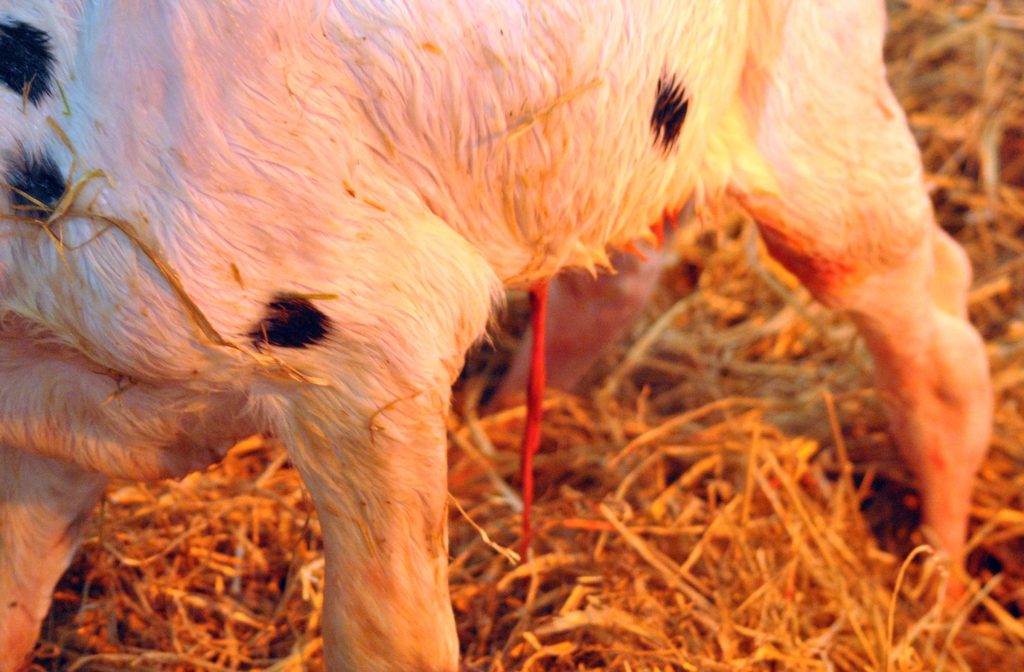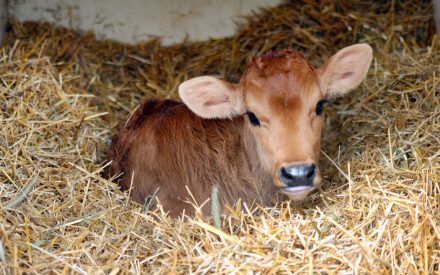One of the simplest best management practices we can do for the newborn calf is navel care. It is considered common practice on the farm. Previous University of Minnesota research showed in a controlled study that umbilical cord care significantly reduced the risk of developing umbilical cord infections. The goal of dipping the newborn calf’s umbilical cord is to promote healing of the umbilical stump, prevent infection, and encourage the umbilical tissue to dry and detach from the calf’s body.

But what about umbilical cord monitoring? Is it a common protocol on your farm? Past studies have shown 15 to 20 percent of dairy calves in the US develop umbilical infections, and 1.6 percent of calf deaths are related to umbilical infections.
Why is caring for the umbilical cord important? The umbilical cord serves as an important conduit between dam and offspring providing vital nutrition and oxygen to the fetus and removing waste products as the calf grows in utero. Once the calf is born the umbilical cord can become a liability, serving as a direct pathway for bacteria and pathogens to enter the newborn calf’s bloodstream, settling into joints, lungs, kidneys, and other organs causing infection, decreased growth rate, and increased morbidity and mortality.
Preventing navel infections is easy. Proper hygiene in the calving area, dipping of navels, and maximizing immunity through proper colostrum management are key. The calf should be provided a clean, dry environment with fresh bedding at birth and when removed from the dam to minimize exposure to potential pathogens. Navel dipping with a seven percent tincture iodine solution is the gold standard, but research findings have found two percent chlorhexidine solution as a viable alternative. Navel dipping helps dry the umbilical cord for healing and to reduce the number of pathogens present on the umbilical cord.
Once the calf’s umbilical cord has been dipped with a proper solution, navel monitoring must occur. Monitor the umbilical cord and stump until the navel is completely dried and healed. Until it is dried and healed, the umbilical stump can serve as a passageway for bacteria and pathogens to enter the calf’s bloodstream. Signs of infection may vary due to the location and nature of the infection, but many times the signs include swelling, foul discharge, and wetness of the umbilical stump lasting beyond the first day of life. However, not all umbilical cord infections can be visually detected. Calves with mild infections may appear quite normal from a distance and react to pain when the umbilical stump is palpated. To monitor the stump, palpate the umbilical stump three to five days of age to make sure it is soft and pliable. By one week of age, the umbilical stump should be the size of your thumb. If it is hard, swollen, or tender to the touch with the calf tucking its belly in or kicking in response, it may be infected. If a calf less than two weeks of age shows signs of illness such as fever and no appetite with no apparent reason, palpate the umbilical stump for signs of infection.
Physical palpation is a good method to monitor calves during the first two weeks of age. Ultrasonography has been shown through research to yield a higher detection rate in calves three to four weeks of age to find umbilical hernias and could be done in conjunction with other health events such as dehorning or thoracic ultrasonography.
Implementing an on-farm protocol for umbilical cord monitoring could improve health in dairy calves by enabling early treatment of calves with umbilical infection and hernias at a very low-cost investment.
Download Article

 The importance of water for dairy calves
The importance of water for dairy calves Heifer blueprint: Best practices for biosecurity
Heifer blueprint: Best practices for biosecurity Heifer Blueprint: Best practices for health management
Heifer Blueprint: Best practices for health management


